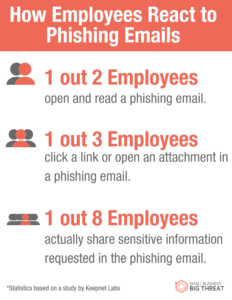Phishing emails are last week’s news (Literally – check out this blog post for more information!), but are still the most common method cyber-criminals use to get access to your small business data and accounts. Recently Keepnet Labs released a report breaking down what sectors are the most vulnerable to phishing attacks.
Phishing Emails: What Your Employees May Do
According to Keepnet Labs, 1 out of 2 employees will open and read a phishing email. 1 out of 3 employees will click a link or open an attachment in a phishing email. Even more frightening, 1 out of 8 employees will actually share sensitive information requested in the phishing email. Keepnet Labs also reported on what business types are the most likely to fall victim. (Check out the businesses most at risk in the report referenced above.)

Raising Awareness
Here at Security Bytes we talk a lot about phishing and other social engineering attacks. This is because cyber criminals are so successful with these attacks! One of the best ways your small business can defend against these is by raising awareness about them. (Refer your employees to Small Business, Big Threat to continue raising awareness!)
Challenge Your Employees
Raising awareness about phishing attacks is one thing, but there are cybersecurity solutions where you can actually test your employee’s skills in identifying fake phishing attacks. This allows you to identify who might need extra awareness training. Some of our suggestions for these solutions include:
Tools to Use to Prevent Phishing Emails
After challenging and training your employees, it is important to also know there are cybersecurity solutions that can help protect you from incoming emails. The following solutions will scan the email for malicious file attachments and malicious links:
As always, the best resource for your business to use to continue its cybersecurity knowledge is Small Business, Big Threat. Explore the website to learn more about small business cybersecurity best practices.